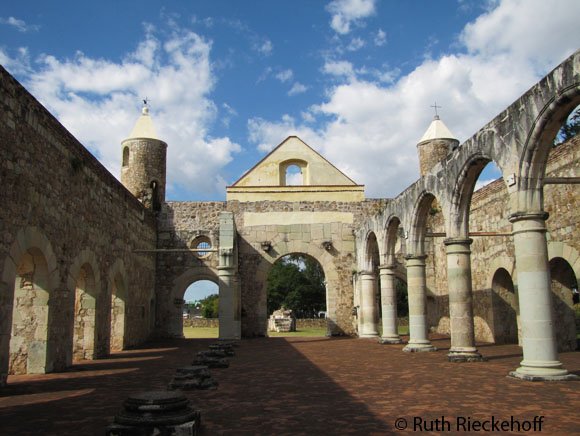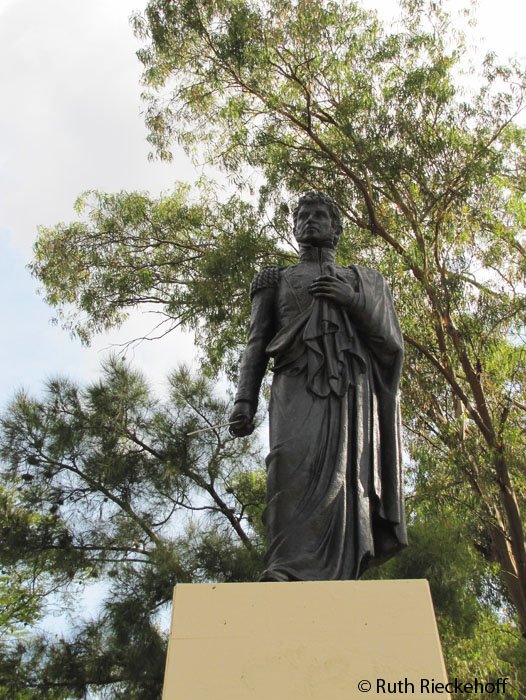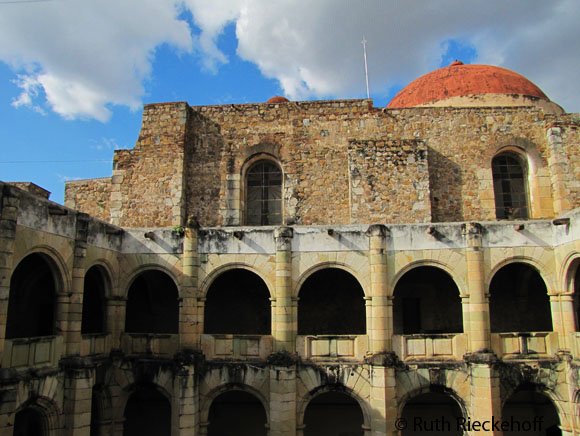This article highlights the Cuilapam Convent in Cuilapan de Guerrero, Mexico.
The world feels very slow after a gigantic lunch. When in Oaxaca, the situation gets worse since you have to deal with comatose symptoms after devouring crunchy tlayudas, thick mole sauces and big chunks of grilled tasajo.
Your body struggles to digest the worst possible combination of grease, carbs and proteins. The best way to deal with those crucial moments after lunch is by throwing your body on a hammock under the shadow of a tree.
But the show must go on. Well, at least for our guide Antonio who was a source of effervescent energy. While chewing the last piece of dessert, Antonio instructed us to pay and move to the vehicle. We followed instructions in our own lazy way. Even though we were moving at 2 miles per hour, there were others slower than us (so no shame in here).
Once the vehicle was in motion, Antonio announced the following, “Don’t worry people, the convent is around the corner.”
Those were not exactly the words I was waiting to hear. The term “ visit a religious sites after a heavy lunch” sounds like a disaster to me.
After stopping at a small parking space, we started to walk towards the Santiago Apostol Ex-Convent located at the Cuilapam de Guerrero town. With every step, the intricate architectural features of the building started to be revealed.
A chapel façade, carved with dogs representing the Dominican order, was flanked by two cylindrical towers. A red dome was seen behind arches and round windows. Nature helped to set up a perfect picture by providing fluffy cloud ranging from bone white to silver. This scene was a punch to my face. I felt wide awake. The lethargy that possessed me a few minutes before was gone.
The chapel I am describing had an interesting feature. It had no ceiling. Some call it “The Unfinished Chapel” since there are stories detailing how the Dominican fathers had to stop the works for lack of funds. Others affirm the indigenous people were afraid of closed spaces. Since the chapel played an important role in the evangelization of the area, it was left open in order to attract the locals.
When we were exploring the chapel, men carrying a coffin appeared in the distance. They were followed by ladies holding flowers and a band playing a funeral march. I observed the priest saying mass when I passed in front of the temple. This is still a worship and community place.
You have to pay a small fee to enter the actual convent. The interior is far more impressive than what you can see for free. Spacious halls painted with murals surround an open-air patio containing a rounded fountain (or well). The festival of arches shows their pink, green and coral hues.
The inside contains murals in a pretty bad state of conservation. The convent is also famous because it is the place where Vicente Guerrero, ex-president of Mexico and independence hero, was killed. It is possible to see the cell where he was held captive before being executed.
There are also opportunities to see the convent from behind and to stand in the terrace were the priest used to relax. With magnificent views of fertile valleys, wavy mountains and a low lying sun, the world started to get slow again. I felt like staying in the terrace to see the sun set.
But there was still another stop in our tour. Antonio asked us to walk towards the vehicle once again. I had no other alternative but to leave the convent in Cuilapam de Guerrero. These places in Oaxaca have the power to accelerate and decelerate your heart rate on a constant basis and I like that.
Did you know about the Cuilapam de Guerrero Convent? Let me know in the comments section below.
















Leave a Reply